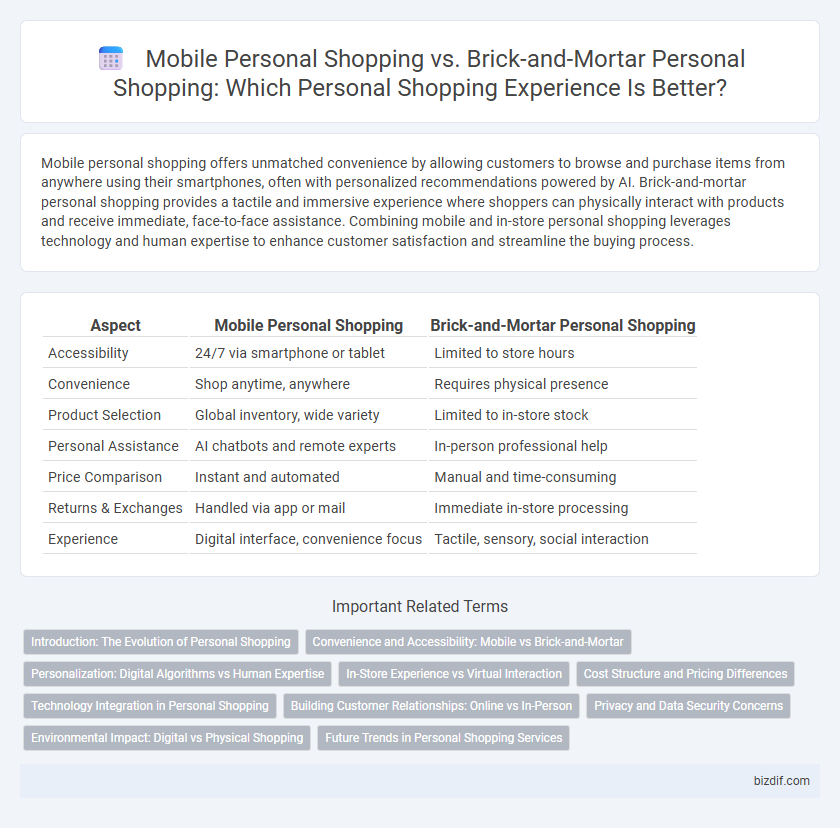Mobile personal shopping offers unmatched convenience by allowing customers to browse and purchase items from anywhere using their smartphones, often with personalized recommendations powered by AI. Brick-and-mortar personal shopping provides a tactile and immersive experience where shoppers can physically interact with products and receive immediate, face-to-face assistance. Combining mobile and in-store personal shopping leverages technology and human expertise to enhance customer satisfaction and streamline the buying process.
Table of Comparison
| Aspect | Mobile Personal Shopping | Brick-and-Mortar Personal Shopping |
|---|---|---|
| Accessibility | 24/7 via smartphone or tablet | Limited to store hours |
| Convenience | Shop anytime, anywhere | Requires physical presence |
| Product Selection | Global inventory, wide variety | Limited to in-store stock |
| Personal Assistance | AI chatbots and remote experts | In-person professional help |
| Price Comparison | Instant and automated | Manual and time-consuming |
| Returns & Exchanges | Handled via app or mail | Immediate in-store processing |
| Experience | Digital interface, convenience focus | Tactile, sensory, social interaction |
Introduction: The Evolution of Personal Shopping
Mobile personal shopping leverages advanced algorithms and real-time data to deliver tailored product recommendations directly to consumers' smartphones, enhancing convenience and personalization. Brick-and-mortar personal shopping offers tangible product interaction and immediate assistance from knowledgeable staff in a physical retail environment. The evolution of personal shopping reflects a shift toward integrating digital technology with traditional services to create seamless, customized consumer experiences.
Convenience and Accessibility: Mobile vs Brick-and-Mortar
Mobile personal shopping offers unparalleled convenience by enabling users to browse and purchase products anytime and anywhere via smartphones and apps, bypassing store hours and physical limitations. Brick-and-mortar personal shopping provides immediate tactile experiences and direct customer service but requires travel and time commitments, which can reduce accessibility for busy or remote shoppers. Mobile platforms leverage algorithms and personalized recommendations to enhance the shopping experience, while physical stores depend more on in-person interactions and visual merchandising.
Personalization: Digital Algorithms vs Human Expertise
Mobile personal shopping leverages advanced digital algorithms that analyze user behavior, preferences, and purchase history to deliver highly personalized recommendations in real-time. Brick-and-mortar personal shopping relies on human expertise, where skilled shoppers assess individual style, fit, and tactile preferences through direct interaction and personalized consultation. Combining algorithmic precision with human intuition can elevate the personalization experience, balancing data-driven insights with empathetic understanding.
In-Store Experience vs Virtual Interaction
Mobile personal shopping offers personalized recommendations and convenience through real-time data analysis and AI-driven chatbots, enhancing virtual interaction with tailored product suggestions and seamless purchase options. Brick-and-mortar personal shopping provides tactile experiences, immediate product trials, and face-to-face consultations, enabling customers to engage all their senses before purchasing. In-store interaction fosters emotional connection and instant gratification, while mobile shopping leverages digital tools to deliver efficiency and accessibility anytime, anywhere.
Cost Structure and Pricing Differences
Mobile personal shopping typically offers lower operational costs due to reduced need for physical storefronts and overhead expenses, resulting in more competitive pricing or flexible service fees. Brick-and-mortar personal shopping involves higher fixed costs like rent, utilities, and in-store staff, often reflected in premium pricing for personalized services. Consumers may find mobile personal shopping more cost-effective, while brick-and-mortar experiences provide tangible product interactions that justify higher charges.
Technology Integration in Personal Shopping
Mobile personal shopping leverages advanced technology such as AI-driven recommendations, augmented reality fitting rooms, and seamless mobile payment systems to enhance convenience and personalization. Brick-and-mortar personal shopping incorporates technology like in-store tablets, smart mirrors, and RFID tracking to provide tailored experiences while maintaining physical product interactions. Both approaches use data analytics to understand customer preferences, but mobile shopping emphasizes on-the-go access and real-time updates.
Building Customer Relationships: Online vs In-Person
Mobile personal shopping leverages data analytics and real-time communication to personalize recommendations, fostering ongoing customer engagement through apps and messaging platforms. Brick-and-mortar personal shopping emphasizes face-to-face interaction, enabling immediate trust-building and personalized service based on in-store cues and body language. Both approaches aim to enhance customer loyalty, with mobile offering convenience and scalability while in-person provides deeper emotional connections.
Privacy and Data Security Concerns
Mobile personal shopping platforms often collect extensive personal data, raising significant privacy and data security concerns due to potential breaches and misuse. Brick-and-mortar personal shopping offers a controlled environment with limited digital footprints, reducing risks associated with data hacking or unauthorized tracking. Consumers prioritizing privacy may prefer in-store services to safeguard sensitive information from extensive online data collection and vulnerabilities.
Environmental Impact: Digital vs Physical Shopping
Mobile personal shopping significantly reduces the environmental impact by minimizing the need for transportation and physical infrastructure, leading to lower carbon emissions compared to brick-and-mortar stores. Digital shopping platforms optimize inventory management and reduce waste through data-driven demand forecasting, unlike physical stores that often face overstock and spoilage issues. The energy consumption of data centers is increasing, but it generally remains less impactful than the cumulative emissions from multiple individual trips to physical retail locations.
Future Trends in Personal Shopping Services
Mobile personal shopping leverages AI-driven apps and augmented reality to offer personalized, on-the-go experiences tailored to user preferences and real-time data. Brick-and-mortar stores are integrating smart mirrors, RFID technology, and immersive sensory experiences to enhance in-store personalization and streamline the shopping journey. Future trends indicate a seamless blend of digital and physical shopping, emphasizing hyper-personalization, convenience, and tech-enabled customer engagement.
Mobile personal shopping vs Brick-and-mortar personal shopping Infographic

 bizdif.com
bizdif.com